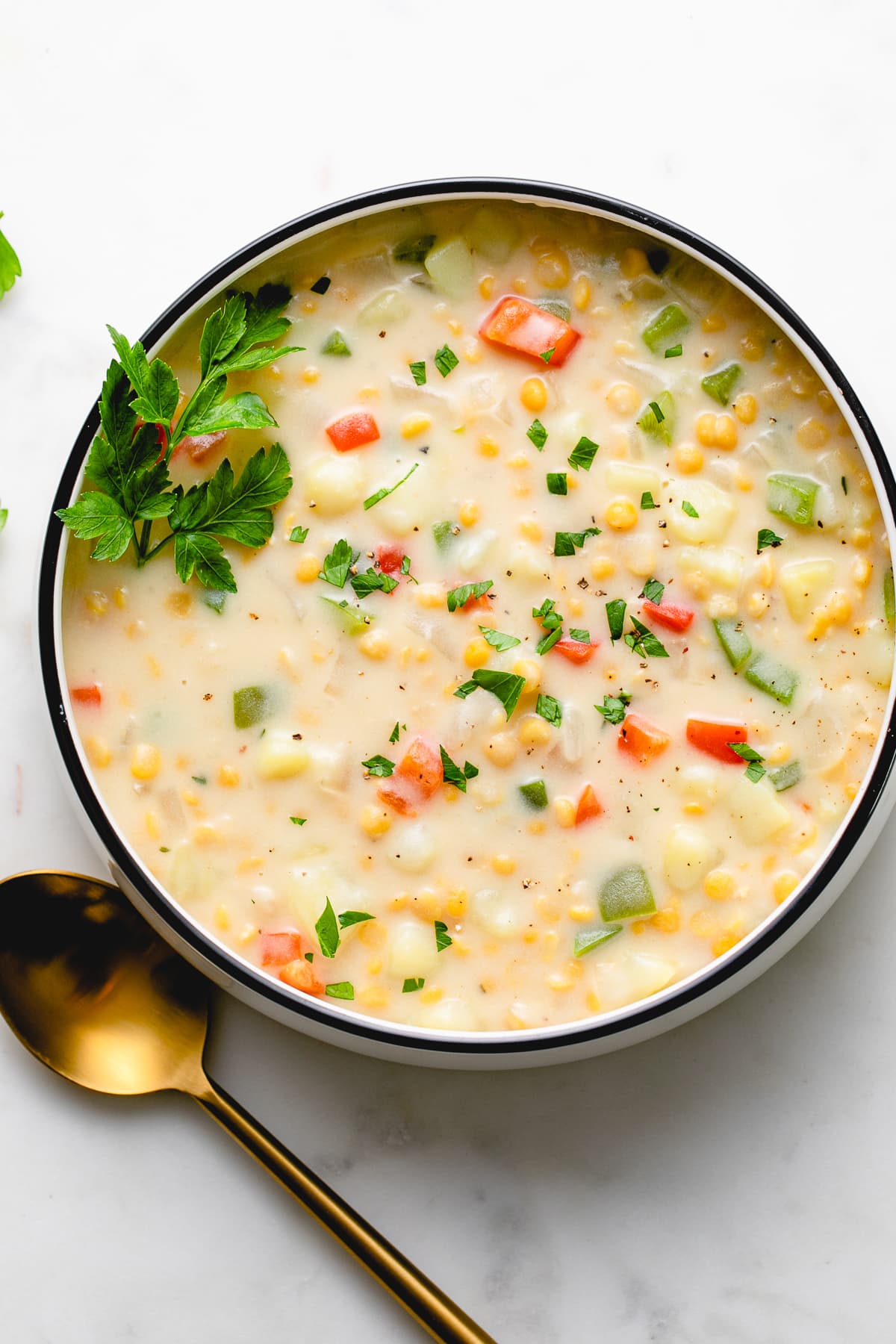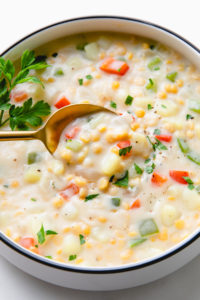Chana Dal + Sweet Potato Chowder
Chana Dal + Sweet Potato Chowder – Full of protein from the chana dal (split chickpeas) and a hint of sweetness from the sweet potato, this creamy vegan chowder recipe is hearty, cozy, and 100% dairy-free!

Healthy and flavorful, this vegan Chana Dal & Sweet Potato Chowder is packed with protein and fiber. The sweet potato adds a hint of sweetness while the jalapeno gives a bit of spice.
It’s a recipe that will definitely be going on my meal rotation for the next few months. It’s everything you’d want in a chowder – creamy, hearty, and satisfying!
This dairy-free chowder recipe is inspired by Bob Red Mill’s and comes from the back of one of their dried Chana dal packages. I love chowders all year long, but they are especially welcome in these cooler months!

What is Chana Dal?
Chana dal is the desi-type chickpeas (garbanzo beans) that have had their outer layer removed and split in half. Resembling yellow split peas, these little golden legumes are widely used in Indian cuisine. Unlike that of the yellow split pea, chana dal hold their shape when cooking.
Being low on the glycemic index makes them an excellent legume for diabetics. Per 1/4 cup, dried, they contain 190 calories, 11 grams of protein, 9 grams of fiber, 2 grams of fat, 1 gram of sugar, and zero cholesterol. They’re a good source of phosphorus, folate, magnesium, and iron. If you can’t find them locally, you can order them online from Amazon (affiliate link).

How To Make Chana Dal & Sweet Potato Chowder
Using one pot and colander, this chowder comes together easily!
First cook your dal and potatoes in water for 20 minutes. Drain and aside.

Next saute your vegetables, set aside with the cooked chana dal and potatoes.

Once the combined flour and non-dairy milk have thickened up nicely, add everything back to the pot and finish cooking for 10 minutes.
And now you’re ready to enjoy the deliciousness!
How Long Will Leftovers Keep?
Leftovers will keep for 5 – 6 days in the refrigerator, stored in a covered container. Simply re-warm on the stovetop or the microwave. Add a splash of water, veg broth, or milk to thin as needed. Because it stores so well, it’s great for weekly meal prep.
Can You Freeze Chana Dal Chowder?
Yes, chowder freezes well for up to 2 months! We love to freeze this chowder using individual small containers that are freezer-safe. And when ready, just pull it from the freezer and warm it up for a warm and cozy meal. You can also freeze larger portions in large ziplock bags or containers.
More Hearty Vegan Recipes!
- Chana Masala
- Spicy Red Lentil Dal
- Sweet Potato Black Bean Chili
- Creamy Vegan Potato Leek Soup
- Chickpea Ratatoullie
- Lemon Chickpea Orzo Soup

If you try this chana dal recipe, please let me know! Leave a comment and rate it below. I love to hear what you think, or any changes you make.
PrintCHANA DAL & SWEET POTATO CHOWDER
Full of protein from the chana dal (split chickpeas) and a hint of sweetness from the sweet potato, this creamy vegan chowder is hearty, delicious, and 100% dairy-free!
- Prep Time: 1 hour
- Cook Time: 35 min
- Total Time: 1 hour 35 minutes
- Yield: Serves 4 – 6 1x
- Category: Soup, Entree
- Method: boil, simmer, saute
- Cuisine: Vegan
Ingredients
- 1 cup Chana dal (split baby chickpeas) or yellow split peas
- 1 sweet potato (orange or white), diced 1/2 – 1/4 inch cubes
- 2 – 3 bay leaves
- 1 tablespoon olive oil or 1/4 cup water (for water saute)
- 1 small red bell pepper, cored and diced
- 1 small green bell pepper, cored and diced
- 1 small jalapeno, most seeds removed and diced
- 1 small onion
- 1 cup vegetable broth
- 2 1/2 cups unsweetened almond milk (or your favorite plant milk)
- 3 tablespoons flour (chickpea, spelt, all-purpose, etc.)
- 1/2 teaspoon thyme
- 1 teaspoon salt, or to taste
- fresh cracked pepper, to taste
- chopped parsley, to serve
Instructions
Soak dal: Rinse Chana dal and remove any pebbles or unsightly peas. In a large pot, soak the dal in about 4 cups of room temperature water for 2 hours or hot water for 1 hour. Drain water. If using yellow split peas, skip this step.
Cook dal + potato: In a large dutch oven or pot, place soaked Chana dal, sweet potato, and bay leaves, cover with 2 inches of water, bring to a boil, cover, reduce heat to low and simmer for about 20 minutes, until dal and sweet potatoes are tender. Place cooked peas and potatoes in a colander, rinse gently and quickly with warm water, set aside. Leave bay leaves with the mix. Don’t worry about getting every pea out of the pot.
Saute veggies: In same pot, heat oil/water over medium heat, add bell peppers, jalapeno, onion, and thyme, saute for 5 minutes, stirring frequently. Remove sauteed vegetables to the colander with the chana dal and potatoes, set aside. Don’t worry about getting every vegetable out of the pot.
Make soup base: In same pot, over medium heat, add flour and 1/3 cup of milk, whisk well until it thickens and lumps are barely visible, stirring continuously, slowly add in the remaining amount of liquids, stirring continuously, continue to heat over medium-low, lumps with dissolve completely as the liquid warms up. Careful to not boil or milk will begin to curdle. Continue to stir and heat until liquids begin to thicken about 7 – 10 minutes.
Simmer: Add in the Chana dal and vegetable mixture, heat over low until everything has warmed, about 10 minutes. Taste for seasoning, add salt as needed, remove bay leaves, and discard.
Serve with crusty bread or oyster crackers and a sprinkle of parsley over top.
Serves 4 – 6
Notes
You may consider using 3 1/2 cups milk w/ 1 veggie bouillon cube. Just be sure you have 3 1/2 cups liquids. Add more liquids as needed.
Edit: I’ve added in soaking the dal first for quicker cooking time. This will ensure that your dal is perfectly tender.
FOLLOW TSV on Facebook, Instagram, Pinterest, Youtube, Subscribe (email), or RSS for more recipes and inspiration!


I have made this chowder multiple times, for my family as well as for potluck dinners. Hearty enough to convince even great my carnivores. Nice balance between the sweet chickpeas and oat milk, and the jalapeños. Great option for potluck dinners because everyone can eat it (vegan and gluten free), and it’s a true crowd pleaser. I made one change: I cooked the chana dal for 15 minutes and then added the sweet potato for another 15 minutes. Works well with pickled jalapeños.
Such a different use for chana dal and we loved it! Thanks for the recipe!
Pretty good! I’d definitely recommend adding some nutritional yeast to it and maybe double up on the sweet potato. Overall a fan, will be making this again!
Delicious!